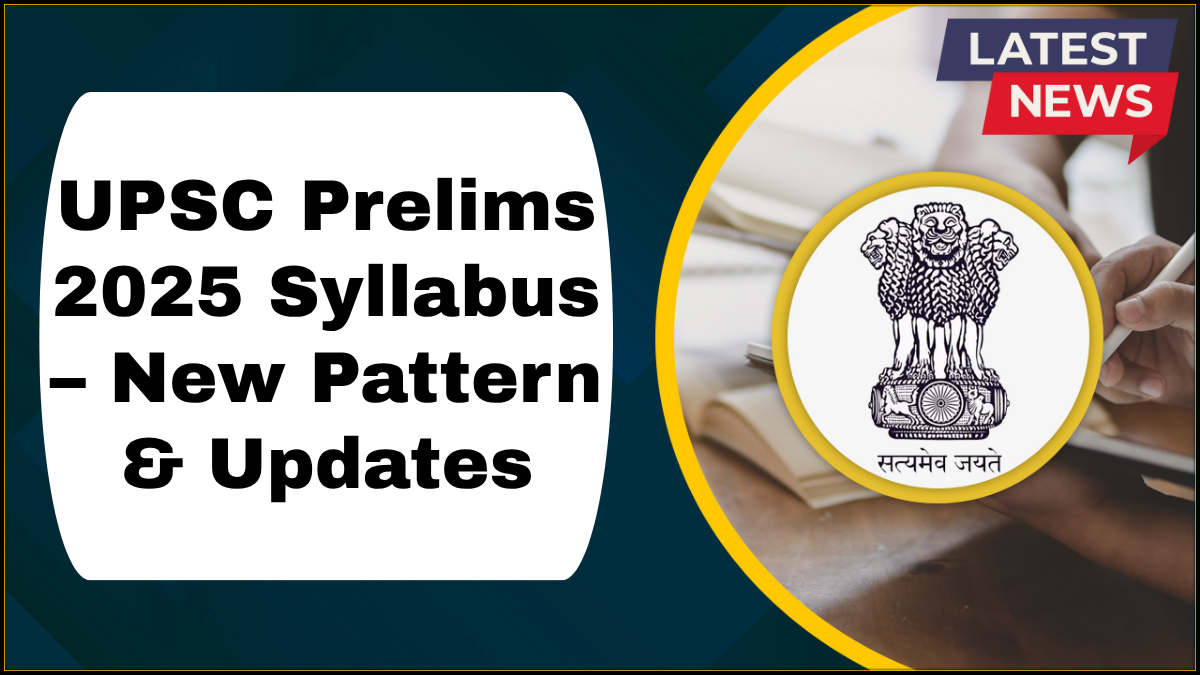The UPSC Prelims 2025 syllabus has undergone some critical updates, reflecting a strategic shift in how the Union Public Service Commission is testing candidates for India’s most prestigious civil services. With changes aimed at aligning the examination with current national and global developments, aspirants must recalibrate their preparation to meet these revised demands.

Here’s a comprehensive look at what’s changed, what’s retained, and how to tackle the new subject pattern effectively.
Overview of UPSC Prelims 2025
The UPSC Civil Services Preliminary Examination is the first stage in the three-tier selection process for IAS, IPS, IFS, and other central services. It includes two papers:
-
Paper I: General Studies (GS)
-
Paper II: CSAT (Civil Services Aptitude Test)
Both papers are objective in nature, but only Paper I counts toward merit ranking. CSAT remains qualifying with a minimum score of 33%.
What’s New in UPSC Prelims 2025 Syllabus?
The new subject pattern for 2025 brings sharper focus areas, emphasizing analytical depth, policy relevance, and contemporary awareness.
1. Greater Weight on Indian Polity and Governance
Polity has always been crucial, but 2025 sees a deeper inclusion of governance mechanisms, policy implementation challenges, and reforms at the central and state levels.
-
Focus on recent amendments and landmark judgments
-
Deep dive into schemes like Digital India, PM Gati Shakti, and One Nation One Election
-
Questions on e-governance, citizen charters, and RTI
2. Environment and Ecology Elevated
With climate concerns gaining global traction, the updated UPSC Prelims 2025 syllabus expands environmental science:
-
New emphasis on climate treaties, national biodiversity goals, and sustainable development indicators
-
Focus on India’s role in global summits like COP28, G20 Environment Track, and Mission LiFE
3. Current Affairs Integration Is Tighter
Instead of being treated as a separate subject, current events are now interwoven with every topic. This means aspirants must link recent developments to static concepts:
-
Example: Linking Article 370 removal with federal structure debates
-
Understanding AI in governance or space policy changes through the lens of science & tech
How the New Subject Pattern Impacts Preparation
The new subject pattern demands a shift from rote learning to application-based understanding. Here’s how to adapt:
Combine Static and Dynamic Content
Merge textbook concepts with real-world developments. For example, study the structure of Parliament alongside debates on parliamentary disruptions and reforms.
Focus on Multi-Dimensional Learning
Topics now bleed into each other. A question on climate may also involve geography, policy, and economics. Develop interdisciplinary thinking.
Prioritize Quality Over Quantity
Rather than hoarding facts, focus on conceptual clarity, critical reasoning, and the ability to eliminate incorrect options—a vital skill under the new pattern.
Detailed Breakdown of Paper I – General Studies
Subject Areas Included in the UPSC Prelims 2025 Syllabus (Paper I):
-
History of India & Indian National Movement
-
Enhanced focus on social reform movements
-
Questions linked to commemorative events like 75 years of independence
-
-
Indian and World Geography
-
Geophysical phenomena like El Niño and monsoon variability
-
Urbanization and disaster resilience
-
-
Indian Polity and Governance
-
Latest constitutional amendments
-
Policies related to education, health, and digital infrastructure
-
-
Economic and Social Development
-
Financial inclusion schemes
-
Behavioral economics in government policy (e.g., Jan Dhan Yojana)
-
-
Environment, Ecology, Biodiversity
-
Greater inclusion of international protocols
-
Focus on India’s environmental legislation
-
-
Science and Technology
-
Role of emerging tech: AI, quantum computing, biotechnology
-
National missions on innovation
-
-
Current Events
-
Must link to all subject areas above
-
UPSC expects analysis, not just awareness
-
Paper II – CSAT Remains the Same but Challenging
Although there is no change in the CSAT pattern, many aspirants underestimate it.
Key areas to master:
-
Reading comprehension with policy context
-
Logical reasoning and basic numeracy
-
Time management during paper
Strategy Tips for UPSC Prelims 2025
-
Daily Newspaper Reading: Prioritize The Hindu or Indian Express with focus on editorials and government updates.
-
Use Government Sources: Refer to PRS India, PIB, NITI Aayog reports, and Economic Survey.
-
Mock Tests + PYQs: Practice with updated mocks that reflect the new subject pattern and solve previous years’ questions regularly.
-
Notes + Revision: Keep concise notes for every subject area and revise in cycles.
FAQs on UPSC Prelims 2025 Syllabus
Q1. Is there a major change in the UPSC Prelims 2025 syllabus?
Yes, while the structure remains the same, the focus areas within subjects have shifted to match current policy relevance, analytical depth, and global developments.
Q2. What is meant by the ‘new subject pattern’ in UPSC Prelims 2025?
It refers to how UPSC has reoriented its question framing—integrating dynamic and static content, expecting more analytical ability, and focusing on emerging issues like climate policy, governance, and technology.
Q3. Has the CSAT pattern changed in 2025?
No, the CSAT remains the same, but the difficulty level is high. Many candidates fail due to underestimation.
Q4. Are current affairs more important in UPSC Prelims 2025?
Absolutely. Current events are now embedded into almost every subject area, and rote memorization won’t be enough.
Q5. What resources should I use to cover the new syllabus comprehensively?
Focus on NCERTs for basics, standard books (Laxmikant, Spectrum, GC Leong), PIB, Yojana, Economic Survey, and quality current affairs magazines like Vision IAS or InsightsIAS.
click here to learn more